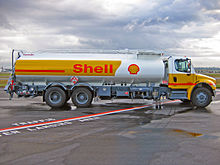Tank truck




A tanker truck (United States usage) or road tanker (United Kingdom usage, both commonly shortened to tanker) is a motor vehicle designed to carry liquefied loads, dry bulk cargo or gases on roads. The largest such vehicles are similar to railroad tank cars which are also designed to carry liquefied loads. Many variants exist due to the wide variety of liquids that can be transported. Tank trucks tend to be large; they may be insulated or non-insulated; pressurized or non-pressurized; and designed for single or multiple loads (often by means of internal divisions in their tank). Some are semi-trailer trucks. They are difficult to drive, due to their high center of gravity.
Size and volume
Tank trucks are described by their size or volume capacity. Large trucks typically have capacities ranging from 5,500 to 9,000 US gallons (21,000 to 34,000 L; 4,600 to 7,500 imp gal).
A tank truck is distinguished by its shape, usually a cylindrical tank upon the vehicle lying horizontally. Some less visible distinctions amongst tank trucks have to do with their intended use: compliance with human food regulations, refrigeration capability, acid resistance, pressurization capability, and others.
Common large tank trucks
Large tank trucks are used for example to transport gasoline to filling stations. They also transport a wide variety of liquid goods such as concrete, milk, water, Gasoline, diesel, and industrial chemicals.
Tank trucks are constructed of various materials depending on what products they are hauling. These materials include Aluminum, Carbon Steel, Stainless Steel and Fiberglass Reinforced Plastic (FRP).
Some tank trucks are able to carry multiple products at once due to compartmentation of the tank into 2,3,4,5,6 or in some rare cases more tank compartments. This allows for an increased number of delivery options. These trucks are commonly used to carry different grades of gasoline to service stations in order to carry all calibration products needed on one trip.
Common small tank trucks
Smaller tank trucks, with a capacity of less than 3,000 US gallons (11,000 L; 2,500 imp gal) are typically used to deal with light liquid cargo within a local community. A common example is a septic service truck (also known as a bowser) used to vacuum clean several septic tanks and then deliver the septic material to a collection site. These tank trucks typically have a maximum capacity of 3,000 US gallons (11,000 L; 2,500 imp gal). They are equipped with a pumping system to serve their particular need.
Another common use is to deliver fuel such as Liquified Petroleum Gas (LPG) to households. These trucks usually carry about 1,000 US gallons (3,800 L; 830 imp gal) of LPG under pressure.
Tank trucks are also used to transport fuel around airports to aircraft.
